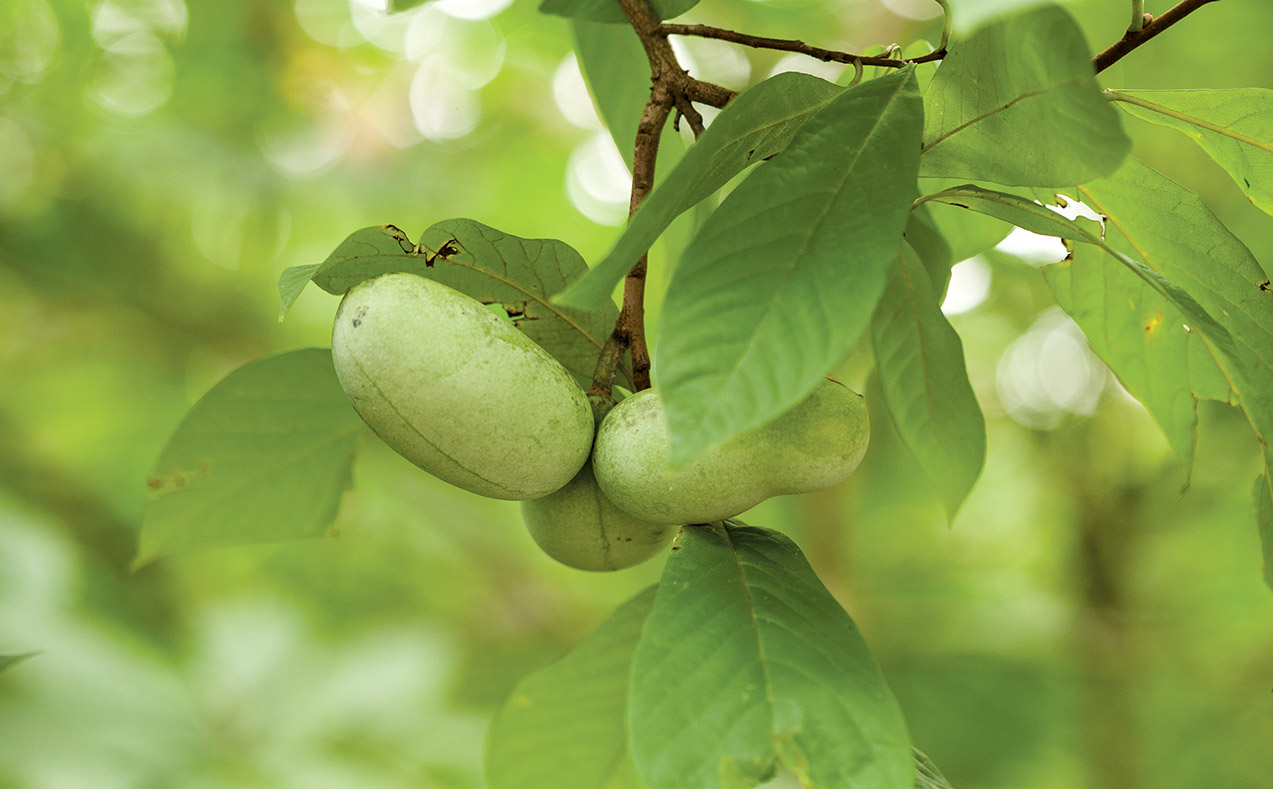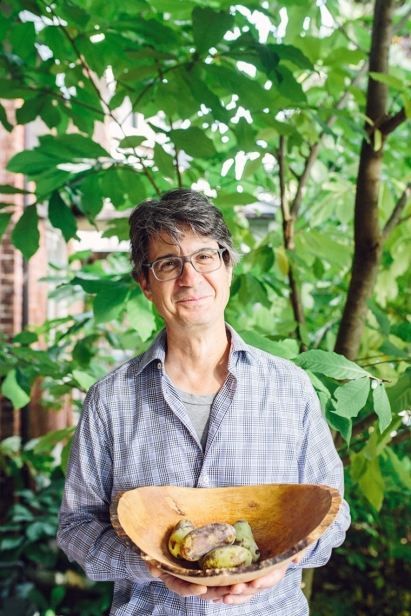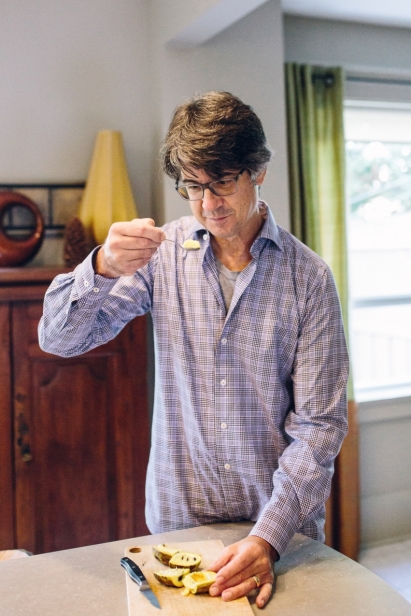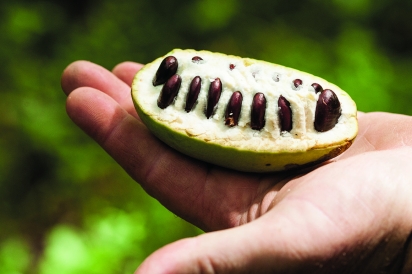Hunting the Pawpaw
There is a fruit that grows — not commonly, mind you — along the rivers and in the forests of some parts of southern Ontario that tastes for all the world like a tropical fruit.
Some say it tastes like a mango, others a papaya, or perhaps a banana.
It has gone by many names — the American custard apple, the West Virginia banana, the bandango.
You’ve heard of it if you’ve ever heard the traditional children’s song “Way Down Yonder in the Paw-Paw Patch.” But you’ve almost certainly never tasted it.
The pawpaw, which usually roams without a hyphen, is the largest edible tree fruit in North America. Its decidedly tropical flavour aside, it is absolutely indigenous to most of the eastern United States and down into southern Ontario, its only Canadian location.
As far back as 1541, members of Spanish explorer Hernando de Soto’s expedition through the southeastern U.S. enjoyed it, likening its flavour to what they called the royal pear.
By some reports, the first American president, George Washington, grew pawpaws on his estate at Mount Vernon in Virginia. The third president, Thomas Jefferson, cultivated the pawpaw at Monticello, his famous estate, also in Virginia — and when he was minister to France for four years beginning in 1785, he had seeds and plants sent to the friends he’d made in abroad.
So what is the pawpaw like to eat?
“Well, people who taste it just lose their stuff,” says Paul DeCampo, a kind of ambassador for the pawpaw, who lives in Toronto and has been growing pawpaws on his urban property for many years.
“People will say, ‘What? This grows in Ontario?’ Because it’s so succulent, so tropical tasting.”
DeCampo describes the flavour as a mix of mango, banana, coconut, all with the texture and some of the flavour of crème brûlée thrown in. “It’s custardy,” he adds. “When you get the ripening just right, it’s almost too satisfying.”
And of course, there’s the additional attraction of being one among the very few who have sampled a rarified delicacy.
“Tasting it gives you a kind of secret knowledge, of something a bit underground, almost clandestine,” he says. That’s because they’re so rare in Ontario, a situation that he, as a pawpaw proponent, would be happy to see change.
Of course, the pawpaw is no longer exotic to DeCampo. He’s had pawpaw trees growing on his Toronto property since 1994, when — somewhat against his wife’s wishes, because she wanted more conventional trees — he planted two of them. Ten years passed before they had their first fruit. “But that’s not so outlandish,” DeCampo says. “You could easily wait four years for a grapevine to ripen.”
The production has been uneven. Last year’s harvest was good, for example — but this year’s yield was only five pieces of fruit. But to his palate, it’s all been superb.
Because the pawpaw, for all its rarity in southern Ontario, is a local fruit, it fits in well with his enthusiasm for the slow food movement. In fact, in 2008, he took some pawpaws to Turin, Italy, where a group of slow food proponents were meeting.
“They couldn’t believe that such a fruit could grow in Canada, the Great White North,” DeCampo recalls. “And since slow food is all about consumption of local foods, the pawpaw, at least when eaten in North America, is congruent with their whole philosophy.”
The pawpaw requires no elaborate presentation. DeCampo prefers to simply wash them, then slice them open to eat with a spoon. They’re good, though, when used in jams or compotes, and make an excellent flavour in ice cream.
As an indigenous fruit, the pawpaw has adapted to local conditions and is untroubled by local pests. You won’t need to apply pesticides, DeCampo says.
The Slow Food Toronto website gives a nice description of the fruit: "The Pawpaw (Asimina trilobal) is the largest tree fruit native to North America …. [The fruit] has an oblong shape and ranges from three to 15 cm in length and width and usually weighing 200 – 400 g. The exterior of the fruit is a thin, green leathery skin with a delicious, creamy interior pulp with large inedible seeds."
Since southern Ontario marks the northern boundary of the pawpaw’s distribution, it’s unclear how it came to be found here. The best guess, DeCampo says, may be that certain groups of natives, especially the Iroquois, encountered it further south and brought it north for cultivation. But that’s only a theory. It may have spread naturally through the Carolinian forest, the deciduous forest, commonly called the eastern woodlands in the United States, that used to heavily cover much of eastern North America.
Though never exactly famous in Ontario, the pawpaw used to be better known. Why has it disappeared so completely from the memories of even culinarily alert people?
DeCampo sees two reasons. First, it was best known to Ontario-based indigenous people — but their knowledge largely disappeared with the sharp reduction of the native population that followed settlement by Europeans. A second reason is that we no longer forage for any of our own food. People used to go into forests and along rivers in search of the fruit, but nowadays little appears on our plates that hasn’t gone through our industrialized food distribution system. And you’ll never encounter a pawpaw in a city supermarket, DeCampo says. It ripens too quickly, bruises too easily, for that to be possible. To procure pawpaws, you need to know where to forage for it yourself, or know of some grower who sells it at the farm gate or in a farmers’ market.
Jonathan Forbes of Forbes Wild Foods in Toronto has been selling pawpaws for years. The season is short — only from late September to late October — but Forbes, buying from foragers or people who grow them, manages to sell three or four hundred pounds of them in a good year, mainly to customers at farmers’ markets.
Growers need the seeds, which are inedible anyway, so customers typically save them and return them to the growers.
Forbes has noticed more people growing pawpaws and figures supplies will be greater in five years.
His own favourite way of eating them is in sorbet — and a customer has reported good results from using them in a daiquiri-like cocktail, which Forbes intends to sample soon.
If you’re interested in growing pawpaws, a number of sources can get you started. Grimo Nut Nursery in Niagara-on-the-Lake sells up to 600 trees a year. Linda Grimo, a co-owner, says that the trees require very little maintenance except for weeding. “You couldn’t ask for an easier tree or more lovely fruit,” she says.
The nursery also sells pawpaws at the farm gate for $6 per pound, she says. But they’re gone almost instantly, she adds.
In Brampton, Humber Nurseries sells pawpaw seedlings from $58 to $130, depending on size. Those interested in growing them will find Dan Bissonnette’s 48-page booklet The Pawpaw Grower’s Manual for Ontario useful. (To buy it, email Bissonnette at dannaturescape@gmail.com).
The fruit has a higher profile south of the border. There has been a pawpaw festival for two decades in Ohio, which has declared the pawpaw its official fruit, and other festivals have popped up in North Carolina, Pennsylvania, Maryland, Delaware and other states.
DeCampo and others think there may soon be a real resurgence in pawpaw consumption in Ontario.
And why not? Tasty, easy to grow, and native to our region, the pawpaw deserves a large space both in our awareness and on our plates.














